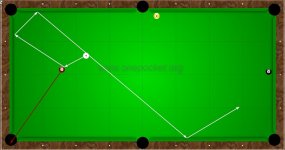C Player perspective:
I tried (success rate):
The 1 rail shot (2/5)
The straight draw shot (1/5)
The follow shot (2/5)
I knew from the moment I saw this layout that it would be low probability "for me" because of where the 9 ball is. I think in almost all the trials, I got "decent" position on the 9, that a B level player would probably have made 80% of.
A comment on the follow shot, the shot itself was definitely the hardest of the opening shots (pocketing ball wise). I had to really bear down on it.
Maybe I'll try them all again tomorrow... maybe not
Video:
https://www.youtube.com/watch?v=DJ8013nTo-Q&feature=youtu.be
I tried (success rate):
The 1 rail shot (2/5)
The straight draw shot (1/5)
The follow shot (2/5)
I knew from the moment I saw this layout that it would be low probability "for me" because of where the 9 ball is. I think in almost all the trials, I got "decent" position on the 9, that a B level player would probably have made 80% of.
A comment on the follow shot, the shot itself was definitely the hardest of the opening shots (pocketing ball wise). I had to really bear down on it.
Maybe I'll try them all again tomorrow... maybe not
Video:
https://www.youtube.com/watch?v=DJ8013nTo-Q&feature=youtu.be
